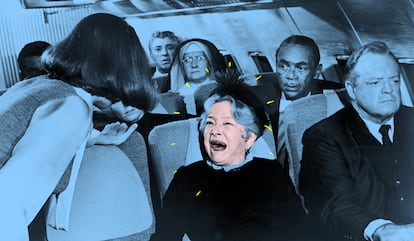The rise of ‘air rage’: Why are fights on airplanes getting more common?
Disruptive encounters in the sky increased by 42% from 2021 to 2022. Experts point to post-pandemic stress, more expensive tickets, poor quality of services and the amount of alcohol consumed on board


The media has dubbed it “air rage,” but Celia D., a 31-year-old stewardess from Asturias, prefers to speak of “high-flying hysteria.” Celia claims to have been a direct witness, and even an involuntary protagonist, of around half a dozen incidents like this in the last couple of years.
From her experience, they occur mainly on flights to tourist destinations and are usually carried out by “relatively young men who have consumed alcohol or other drugs before boarding or on board over the course of the trip.” The flight attendant doesn’t include other types of incidents that are much more common, “but, in general, easy to redirect,” such as a passenger smoking in the bathroom, insisting on using electronic cigarettes on the aircraft or suffering a panic attack or an anxiety attack.
Celia agreed to an interview on the condition that her anonymity be respected. She wants passengers to remember into account that flight attendants, no matter how much they have been trained to deal with uncomfortable situations and resolve conflicts, are not security personnel and do not have the resources to restore order: “We have very clear protocols on how to act in cases of cabin depressurization, turbulence or emergency evacuations, situations that, luckily, very rarely occur. But when it comes to calming down people who behave violently and put the safety of the flight at risk, we very often depend on the help of other passengers.”
Insults and attacks
Celia reviews a series of potentially high-risk situations that the press has reported on in recent months. On June 15, a man jumped from a connection platform onto the runway at the Málaga airport in an attempt to board a flight bound for Morocco that was about to take off. On June 20, also in Málaga, a 61-year-old British citizen was arrested after assaulting his partner during a flight from Leeds.
In May, a senior executive on leave insulted, intimidated and attempted to assault American Airlines attendants on the Barbados-Miami route because, according to his own testimony, he was not offered a vegan menu option that he considered “satisfactory” and was treated in a “negligent and disrespectful” manner.
Although the case that most attracts Celia’s attention is that of a 33-year-old American who tried to open one of the emergency exits shortly before a flight from Los Angeles landed in Boston. Several assistants attempted to prevent him from doing so. The man attacked them with a broken metal spoon, causing minor neck injuries to one of them. He now faces a probable fine of up to $250,000 and a sentence of several years in prison.
Celia comments, after reading the news, “that the attempt to open an emergency exit in mid-flight is potentially very dangerous. It can only be attributed to a fit of madness or a suicidal impulse.” And she adds that, for the flight attendants, facing a reckless passenger with an improvised knife in his hands must have been “a terrifying experience, one of those situations for which you will never be fully prepared no matter how much training you receive.”
The summer of our discontent
In an article in Bloomberg, the motor and aviation journalist Ragini Saxena affirms that these episodes are going to be “more frequent than ever now that the summer tourism season is starting in the northern hemisphere.” Citing other recent examples of uncontrolled violence on flights, Saxena concludes that “there is no pattern” or set of clear guidelines that would allow a specific flight to be classified as high risk in order to assign security personnel accordingly, a measured recommended by the 2015 update of the Tokyo convention, the international protocol that regulates behavior on commercial aircraft.
For the Bloomberg editor, guaranteeing the safety of the more than 96,000 daily flights that take place around the world is a formidable challenge that airlines face without optimal resources. In 2022, the International Air Transport Association (IATA) reported that “notable disturbances” had occurred on one in every 586 recorded flights during the year, a considerable increase from 2021, when they occured on one in 835. IATA based its statistics on a sample of more than 20,000 flights operated by 40 different companies.
Saxena attributes these disturbing statistics to a post-pandemic change in habits. After the drastic reduction in air traffic that occurred in 2020, we earthlings have recovered the habit of flying, but we do it in an “increasingly anxious and reticent” way. Celia D. has noted behaviors that could be attributed to post-pandemic anxiety: passengers increasingly consume more alcohol both immediately before boarding and during flights.
Saxena believes that other possible factors include the increase in prices and the mental health problems attributable to the impact of COVID, in addition to the increasing hostility towards the airline industry due to chaotic airports and frequent flight cancellations and loss of luggage. To this should be added practices like the use of increasingly aggressive dynamic pricing algorithms, prohibitive fees for excess baggage and overbooking.
Caged beasts
Australian journalist Michael Gebicki agrees that “air unrest continues to grow” and is on its way to becoming a contemporary epidemic. Gebicki recalls that “until well into 2021, frequent flyers had gotten used to an almost-idyllic situation with almost empty flights and, therefore, more comfortable, controlled prices, more humane treatment and hygienic measures that for many people implied a sense of security and control.” Starting that year, there was a sudden return to normality post-pandemic that upset many passengers: “Most find intolerable situations that they would have accepted naturally in 2019.” And from that dissatisfied majority emerges that (immense) minority that engages in uncivil practices.
This would explain the record 1,973 serious incidents reported by US companies in the first months of 2022, a figure that is on track to be surpassed in the very short term, but is ten times the average of the last five pre-pandemic years. Gebicki believes, like Saxena, that companies should recognize that part of this worrying drift is the consequence of “a series of very dubious corporate practices.” The journalist deplores, in particular, “the deterioration of the basic service in the cheapest flight options,” which contrast with “the priority, first class and similar options.” He believes that a large part of the airlines are consolidating a “segregated” flight model in which the preferred user is taken care of and the tourist class user is “mistreated.”
The fact that alcohol is, by far, the most profitable of the products sold on board does not help, either. “The trigger can be a simple dispute over the back of a seat. The conversation rises in tone, passengers who feel immersed in a situation that they dislike and make uncomfortable begin to raise their voices, respond with hostility to the mediation attempts of the attendants and, in extreme cases, end up raising their voices and resorting to fists.” Flight attendants are not trained to have sufficient skills for conflict resolution, he notes, having received some ten hours of training on it.
Celia D. agrees that the “laboratory” conditions of flight attendant training have “nothing to do” with the real situation of facing “a drunk, nervous and angry passenger.” The stewardess concludes that these unpleasant circumstances are “more than occupational hazards.” “Up there,” she tells us, “you’re locked in a cage with a group of people you don’t know. If there are no incidents, an airplane is a work environment like any other.” The problem comes when a beast sneaks into the flying cage.
Sign up for our weekly newsletter to get more English-language news coverage from EL PAÍS USA Edition
Tu suscripción se está usando en otro dispositivo
¿Quieres añadir otro usuario a tu suscripción?
Si continúas leyendo en este dispositivo, no se podrá leer en el otro.
FlechaTu suscripción se está usando en otro dispositivo y solo puedes acceder a EL PAÍS desde un dispositivo a la vez.
Si quieres compartir tu cuenta, cambia tu suscripción a la modalidad Premium, así podrás añadir otro usuario. Cada uno accederá con su propia cuenta de email, lo que os permitirá personalizar vuestra experiencia en EL PAÍS.
¿Tienes una suscripción de empresa? Accede aquí para contratar más cuentas.
En el caso de no saber quién está usando tu cuenta, te recomendamos cambiar tu contraseña aquí.
Si decides continuar compartiendo tu cuenta, este mensaje se mostrará en tu dispositivo y en el de la otra persona que está usando tu cuenta de forma indefinida, afectando a tu experiencia de lectura. Puedes consultar aquí los términos y condiciones de la suscripción digital.
More information
Últimas noticias
Most viewed
- Reinhard Genzel, Nobel laureate in physics: ‘One-minute videos will never give you the truth’
- Oona Chaplin: ‘I told James Cameron that I was living in a treehouse and starting a permaculture project with a friend’
- Pablo Escobar’s hippos: A serious environmental problem, 40 years on
- Why we lost the habit of sleeping in two segments and how that changed our sense of time
- Charles Dubouloz, mountaineering star, retires at 36 with a farewell tour inspired by Walter Bonatti










































